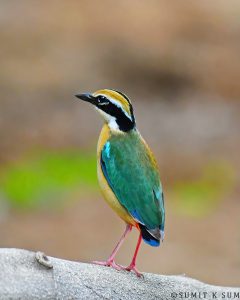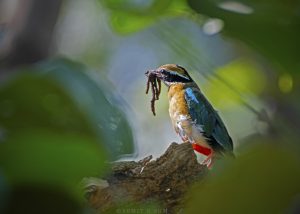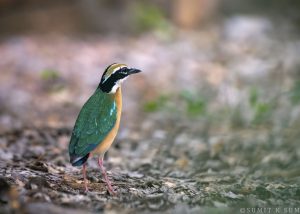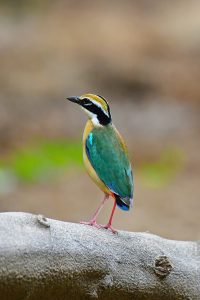Meet the Indian Pitta — a tiny burst of colours with a call that echoes through the forest like a flute. Also known as the Navrang in Hindi, meaning “nine colours”, this little bird lives up to the name. With its rainbow-like plumage and signature “wheeeet-tew” whistle, it’s one of India’s most charismatic and secretive ground-dwellers.

Though shy and often heard more than seen, catching a glimpse of this gem of the undergrowth is a treat for any bird lover. Even we Nature Storytellers love every sight of this bird.
Identification of Indian Pitta
The Indian Pitta is a small, stout bird — about 18–20 cm in length — but what it lacks in size, it more than makes up for in colours.

Here’s how to spot it:
| Bright green back that blends with forest foliage |
| Electric blue wing patch that’s eye-catching mid-flight |
| Buff-orange underparts and a yellowish belly |
| Black crown bordered by a white supercilium (eyebrow stripe) |
| Short tail and pinkish legs |
| A stubby bill that’s perfect for digging up worms and insects |
Despite its flamboyant look, the Indian Pitta is surprisingly elusive. It prefers hopping around on the forest floor, well-camouflaged under leaf litter.
Distribution and Habitat of Indian Pitta
The Indian Pitta is found mainly in the Indian subcontinent. It’s a short-distance migrant, breeding in central and northern India and then moving southwards for the winter.
It favours:
|
|
|
|
Though mainly a forest bird, during migration, it can turn up in unusual places — even city gardens and parks, especially after rain. It’s most active during dawn and dusk, making it a classic crepuscular bird.
Also Read: Sarus Crane
Behaviour and Diet of Indian Pitta
The Indian Pitta is a quiet, solitary bird but don’t let its discreet personality fool you. It’s a skilled ground forager, often seen hopping like a wind-up toy as it searches for food.

Its diet consists mainly of:
- Earthworms
- Insects (like ants, beetles, and grasshoppers)
- Snails and small invertebrates
Using its strong bill, it probes the soil and leaf litter to snatch up hidden snacks. It’s also known to flick aside leaves with its beak — a classic foraging technique among pittas.
Like the Indian Eagle Owl, the Indian Pitta is often heard before it’s seen. Its call, a loud “wheeeet–tew”, is usually the first clue that a pitta is nearby. The sound is flute-like, repetitive, and unmistakable once you learn it.
Breeding and Nesting of Indian Pitta
Breeding season for the Indian Pitta typically aligns with the monsoon — from June to August, depending on the region. This is when its vocal activity peaks.

Nesting behaviour is quite unique:
| Nest | A spherical, domed structure with a side entrance, made of twigs, grass, and leaves, often placed low in a bush or on the ground |
| Clutch | Usually 4 to 5 eggs, white with speckles |
| Parental care | Both male and female are involved in raising the chicks |
Despite being ground-nesters, Indian Pittas are quite clever about camouflage and choose well-hidden spots to avoid predators.
Also Read: Indian Paradise Flycatcher
Conservation Status of Indian Pitta
The Indian Pitta is listed as Least Concern on the IUCN Red List — good news! However, like many forest birds, it is affected by habitat loss, particularly due to deforestation and fragmentation of breeding grounds.

Because it’s migratory, it also relies on a network of healthy habitats across regions. Luckily, its adaptability helps it survive in well-wooded urban areas and secondary forests too.
Indian Pitta Fun Facts
- “Navrang” isn’t an exaggeration! The Indian Pitta’s plumage includes hues of green, blue, buff, orange, white, black, and more — a true feathered rainbow.
- It belongs to a group of birds often called the “jewel-thrushes” for their dazzling appearance and ground-dwelling habits.
- Despite their bright colours, Indian Pittas are masters of stealth. You might hear one calling just metres away — and still not spot it!
- It plays an important role in forest ecosystems by keeping insect and worm populations in check.
The Indian Pitta may not be the loudest or most social bird around, but it’s certainly one of the most enchanting. Often hidden in plain sight, it invites patience and attention — the kind of birdwatching joy that comes with quiet forest walks and tuned-in ears.
So next time you’re near a patch of forest after the rains, pause. Listen for that sweet “wheeeet-tew” call. You might just be lucky enough to glimpse this colourful treasure of the forest floor.
| Get your favourite Indian Pitta photograph framed for your wall – Request Now @+91-9540178459 |
